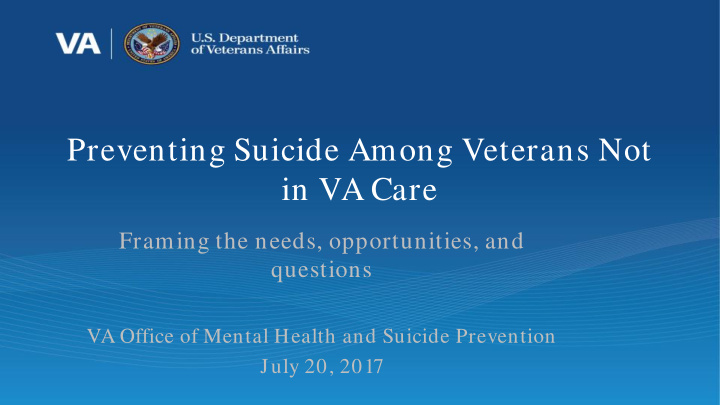



Preventing Suicide Among Veterans Not in VA Care Framing the needs, opportunities, and questions VA Office of Mental Health and Suicide Prevention July 20, 2017
Preventing Veterans Suicides • VA can’t do it alone – Veterans who come to VA for health care are part of their communities – Most Veterans do not come to VA for health care
Veterans Are Parts of Their Communities R = 0.81
Most Veterans do not come to VA for health care • The total Veteran population is approximately 20 million – Approximately 9 million are enrolled with VA for health care services – Approximately 6 million use VA health care services over the course of a year • In 2014, an average of 20 Veterans died from suicide each day – 6 were current or recent users of VHA health care services – 14 were not
Veteran Suicide Decedents in 2014 Currently Identified Points of VA Connection* N. Absent from all Other Categories A. Recent VHA Encounters 7.4% 31.5% B. Recent Non-VA Fee Basis Care 0.2% C. Recent VHA Medication Fills 0.3% M. Known to VBA D. Recent VBA Educational 43.9% Support 1.6% E. Recent Comp/Pension 3.7% F. Recently Applied for Comp/Pension 0.7% L. Applied for Comp/Pension G. VHA Encounters in 2000-2012 in 2000-2012 0.7% * Mutually exclusive groups 5.1% Recent: 2013-2014 K. Received Comp/Pension J. VBA Educational Support I. VHA Enrolled H. Non-VA Fee Basis Care in 2000-20012 0.0% in 2000-2012 1.7% 3.3% in 2000-2012 0.0%
Other VA and DoD Connections The pie chart includes • • Health care from VHA • Compensation/Pension and Educational programs from VBA Other programs to be added include • – Other VBA programs • Loans • Vocational services • Insurance – Vet Centers – Department of Defense • Veterans who – Are active members of National Guard and Reserve units – Who utilize health care services through TRICARE and Military Treatment Facilities
Conceptual Model • Prevention must target multiple actionable populations • The impact of the overall strategy is (approximately) the sum of the impacts of interventions toward actionable populations • Impact of = P*R*E*S where – P= actionable population – R= reach into the population – E= real world effectiveness of the preventive intervention – S= suicide rate in the population
Process for Learning and Acting Identify how to make an impact Implement Strategies Analyze the 20 Per Day Strategies/Intervention • Develop models • Collect required data to • Identify potential settings and • Partnerships regarding Population understand the 20 Veteran contexts for outreach and Veteran outreach, Impact suicides per day (VBA, programming messaging, and other Veteran Centers, etc.) • Coordinate with Federal, State, strategies • Identify partnerships and data Local governments and external • Push intervention (e.g., resources to support the stakeholders public service outreach) strategy • Develop action plans • Analyses and reportin g Draft- pre-decisional – not for circulation
Defining Actionable Groups Groups may overlap • – Multiple contacts may reinforce each others Reach • Direct to individual identifiable Veterans or indirect, – Through partners – Through public messaging – They should include: • – States and communities – Health care insurers or providers • Medicare, Medicaid, and other payers • Health systems – Veterans Services Organizations and other community groups – Work place – Interest groups • Hunting and shooting sports – Accounts for 2/3 of Veteran suicides
Characterizing Risks and Burdens • Collaboration with NVDRS to characterize deaths • Analysis of existing data sets that include Veteran data – National Survey of Drug Use and Health – National Health Interview Survey – American Community Survey • Other
Preventing Veterans Suicides • VA can’t do it alone
Recommend
More recommend